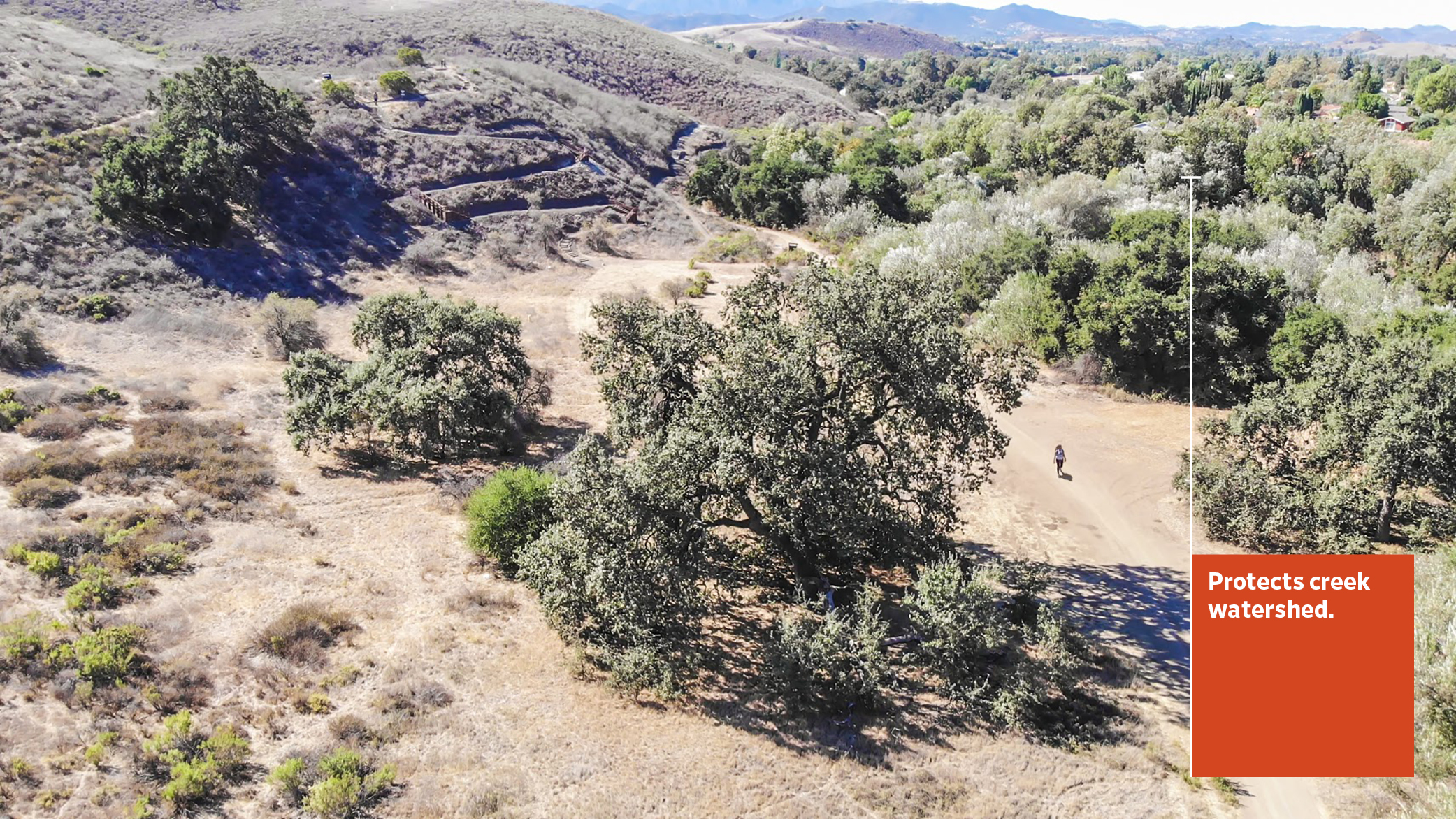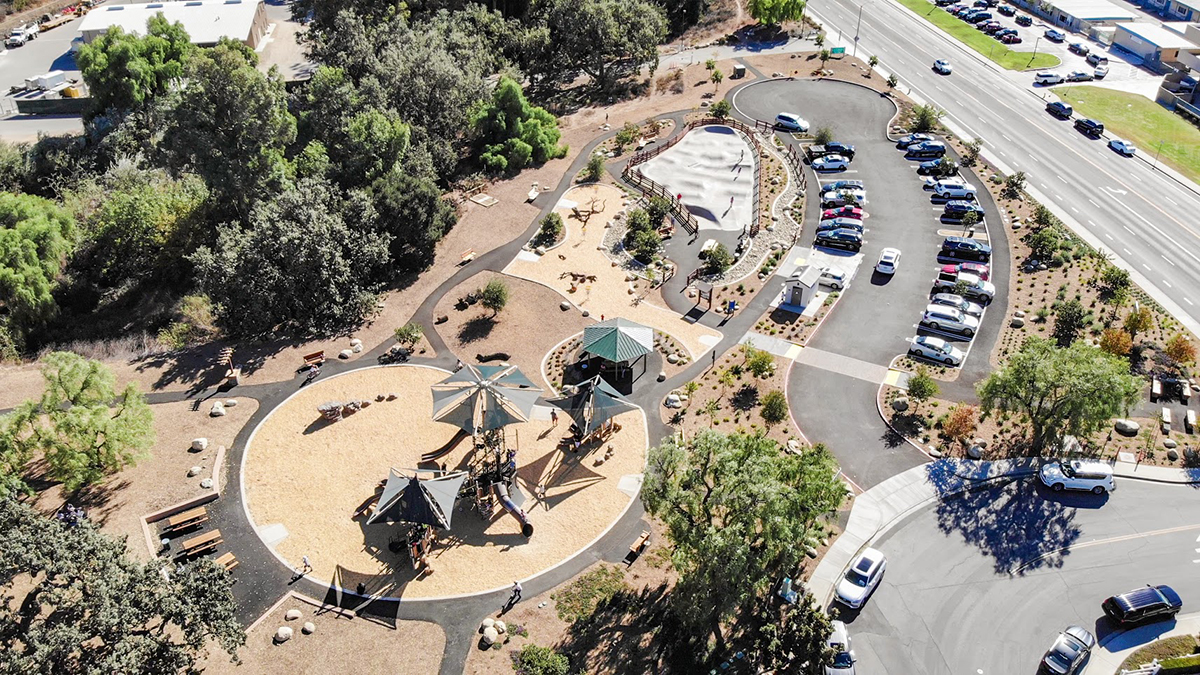
Sapwi Trails Community Park / Conejo Recreation & Parks District
In Thousand Oaks’ Lang Ranch neighborhood, the 145-acre Sapwi Trails Community Park was largely preserved as natural lands in order to create recreational space that better protects the Lang Creek watershed and native oak tree landscape. Just 17 acres were developed as trail heads, bike park, playground, pump track, and other amenities. No turf lawn was added, which means the park reduces water use by 90 percent in comparison with a conventional park. The $7.5 million park, led by planners and landscape architects at the Conejo Recreation & Park District and RRM Design Group, is a model for how to preserve ecological systems while improving access and dramatically reducing water use in arid climates.
Background:
The original plan was to build a conventional park in the 145-acre open space but geotechnical studies revealed that the area’s slopes and soils were unstable. Tens of millions of dollars would have to been spent to regrade and amend the soils of the parcel, causing damage to the fragile Lang Creek ecosystem. Instead, a new sustainable park concept was developed that conserved water, preserved topography, required little regrading, and protected the creek watershed.
Climate change is creating a drier climate in California and increasing drought conditions. Designing a park that would require lots of water to maintain would make little sense, so the landscape architects decided to highlight the beauty of the arid natural landscape. In an introductory video, Jim Friedl, general manager of Conejo Recreation & Park District, said: “this is what parks in the future are going to look like.”
Through extensive outreach and consultation with a range of government and community stakeholders, the District developed a design that prioritized low-impact recreation, stewardship, and sustainability. At the same time, a range of new amenities were incorporated, including 6 miles of multi-use hiking, bicycling, cross-country running, and horseback riding trails; a bicycle and scooter obstacle course, with bumps that help riders accelerate speeds, a non-motorized glider area, and an 18-hole disc golf course.
According to Andrew Mooney, ASLA, senior park planner with Conejo Recreation & Park District, the project helped restore portions of the watershed of Calleguas Creek, into which Lang Creek deposits, and protected the natural landscape to the greatest extent possible within the park.
The restoration efforts of Lang Creek involved removing trash, debris, silt, and non-native plant species. Four bridges protect and preserve the creek, spanning well beyond its banks, providing erosion control and slope and soil stabilization. The park retained all the existing native vegetation, including over 400 oak trees.
New native and drought tolerant landscaping, permeable trails, pervious parking lots, bioswales, and naturally pervious drainage features, and mulch around trees all help to conserve water and retain on site or direct flows towards the creek.
Gabion retaining walls were incorporated to reduce the need to regrade the landscape. Gabion walls also allow water to soak into the ground instead of trapping it at the surface or storm drains.
There are also a number of other water and energy saving technologies: both above and below grade bubbler irrigation systems; gator bags, which slowly release water to newly planted trees directly to the root system with no run-off or evaporation; and restroom buildings topped with photovoltaic panels.
Sapwi Trails Community Park was made possible by a $2.5 million grant from the City of Thousand Oaks, and a $1.76 million grant from the Santa Monica Mountains Conservancy. The rest of the project costs was provided by the Conejo Recreation & Park District.
The park resulted from a multi-agency collaboration between the City of Thousand Oaks, Conejo Recreation & Park District, Calleguas Municipal Water District, Ventura County Watershed Protection District, California Department of Fish and Game, SoCal Gas, and Southern California Edison. In addition, Conejo Recreation & Park District worked with key user groups, including the Thousand Oaks Soaring Society, Conejo Disc Golf Club, Concerned Off-Road Bike Association, and Thousand Oaks High School Cross Country.
- Sapwi Trails Community Park, Conejo Recreation & Park District
- Grand opening held for sprawling, $7.5 million Sapwi Trails Park in Thousand Oaks, VC Star
- Park honored for design excellence, Thousand Oaks Acorn
- Provide dedicated funding for green stormwater infrastructure.
- Incentivize planting of locally/regionally appropriate and biodiversity-supporting vegetation.
- Protect and enhance natural vegetative buffers, including wetlands and water’s edge plantings, along coastlines and inland waterways.
- Prioritize retention and expansion of green space; address inequities in access to open space and recreation.
- Preserve wildlands.
- Provide equitable access to transportation options, including safe, connected pedestrian, bicycle, and transit routes.

Sapwi Trails Community Park / Conejo Recreation & Parks District